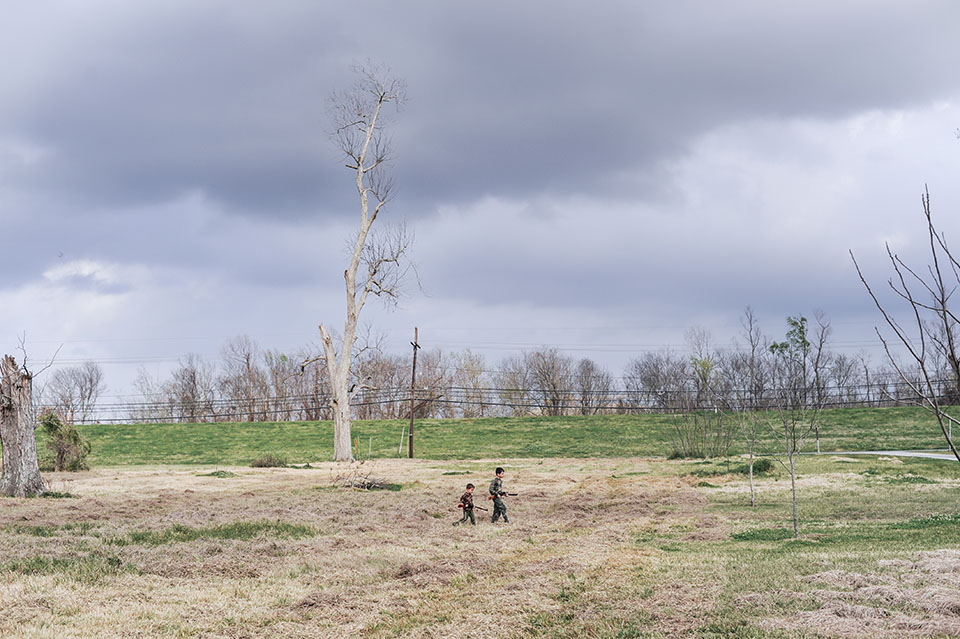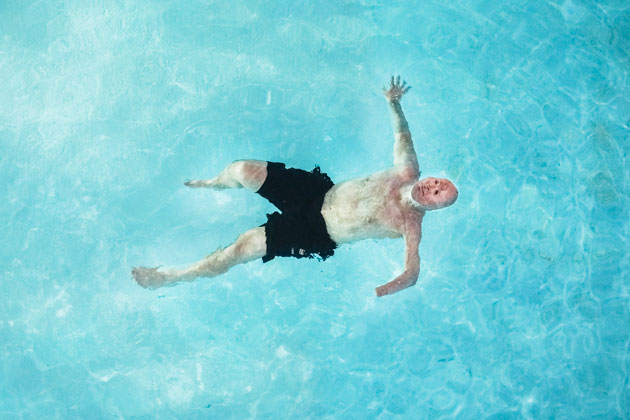Photojournalist Peter van Agtmael considers his third book, Buzzing at the Sill, the latest chapter of what he calls “one greater book”—a sweeping exploration of the September 11th attacks and the impact of the wars in Afghanistan and Iraq on soldiers and their families. His project began with his 2009 book, 2nd Tour, Hope I Don’t Die, and continued with Disco Night Sept. 11, which appeared in 2014. In Buzzing at the Sill, published by Kehrer Verlag, he shifts his attention to unexplored corners the United States after he realized “how little I know about my country.”
The Magnum photographer first went to Iraq in 2006 when he was 24, and he covered the conflicts there and in Afghanistan for several years before returning to the States. With 72 images pulled from his journalism assignments and others he shot while traveling throughout the country, Buzzing at the Sill examines the reverberations of 9/11 through glimpses of daily American life that often have the intimate feel of a snapshot. The photos in Buzzing at the Sill depict vulnerable, grieving, celebrating, and sometimes threatening Americans, collectively offering a cohesive and sharp reading of the country, with a powerful undercurrent of alienation. “In America, we somehow feel immune,” he writes in Buzzing at the Sill, “but in any country at war, the first thing they’ll tell you is that they didn’t think it could happen there.”
I talked with van Agtmael about making this book and what it might say about the political climate in the United States today.

Mother Jones: Can you tell me about the title, Buzzing at the Sill?
Peter van Agtmael: Buzzing at the Sill is from a Theodore Roethke poem called “In a Dark Time.” I’d heard a small part of it in a play, a sort of sci-fi play about morality in a virtual reality universe. Nothing to do with the book precisely, but it was a great play. I read the poem afterwards because I was intrigued and had one of those strange senses: “This poem is kind of important to me. I don’t know why, but I’m going to just keep it in the back of my mind.” I just kept coming back to it. As I started putting the book together and writing the stories for it, this idea of buzzing as a word kept popping up in my brain.
I started the book with [the story] of a vulture that flapped up to this window sill outside of a burn ward at a military hospital in Texas. I guess it could smell the rotting flesh through the walls and was just trying to desperately and aggressively get in through that window, I don’t know, to try and feast on the flesh. It was really a troubling moment. But apparently it happens all the time, because the soldiers in recovery and the nurses were totally accustomed to the presence of those vultures.
When I started thinking of the decisions that led me down the road first—which was part of Disco Night Sept. 11 and then the buzzing being— I somehow couldn’t ignore the urge to do things that kind of defy logic. And I liked the poem, I liked the ring of it. I was sitting with David Allan Harvey one day when he pointed out how appropriate the title was for the things I was talking about.
MJ: In what way do you see that Buzzing at the Sill continues the narrative you built with Disco Night?
PVA: I went out to cover the wars in Iraq and Afghanistan fundamentally because I was interested in war as a notion and in experiencing it. I was interested in history and how societies form. I was interested in the recent history of what had provoked these wars. So when I finally got out there, I was really seeing the wars through the American perspective, much more than through being embedded with American soldiers and Marines. I realized in that process how little I knew about my own country. I had grown up in the suburbs and, after college, I moved out of the country, so I didn’t really know the place well. When I started following soldiers and their families back home, it provoked a lot of the questions about who we are as a nation, questions I realized couldn’t be explored through the more limited framework of looking at the military at war and at home. So that inspired these trips [in which] I began to explore America in more general terms. I really started this work in 2009. I got the bulk of it done as I was easing out of Disco Night. I started them as almost concurrent projects.




MJ: What was your thinking as you approached putting together this body of work? The photos feel like they’re pieced together from assignments or from different stories.
PVA: At first it wasn’t meant to be a book, although I’m always thinking about that in the back of my mind. It started off as a series of exploratory road trips that I was doing with Christian Hansen, who I dedicated the book to. Then I started getting some assignments to go shoot in America because I think editors liked the pictures I was taking. What I was doing for those assignments wasn’t always directly tied to what I was doing for myself, but it gave me the space to photograph. I started getting assignments that dealt with my own interests and made some pictures in that direction. A lot of it was just photographed through general exploration. It was sometimes provoked by assignments, then I’d go back on my own dime if I really clicked with a place. And sometimes it was just hanging out with my family or friends.
MJ: How did you approach the editing? How were you going to tie the pictures together?
PVA: I’m a constant editor. Every few months or so I make a ton of 4×6 prints. I put them on a magnetic board and I live with them for a while to see what bubbles to the surface. A lot of this was part of Disco Night originally, and I suddenly started realizing, “If I keep working on this because I’m not done and I put all that in Disco Night, how can this be one book? Is it going to be too long and bloated and crazy?” Then I started thinking, “Okay, I have so many other questions about America, when do I stop?” I started thinking about each book being a chapter in one bigger book and that gave me the space to cut it off at a certain point. I needed to have some kind of thematic focus to the work.
I was taking all these prints and I brought them to the Magnum meetings, trying the old Josef Koudelka trick: Give them to photographers, who are getting bored during the talks about the economics of the agency, to look through with a pen. They’ll separate them in two piles—what they like and what they don’t like—and put their initials on the back. I started to find the core pictures that people seem to relate to. I’d ask myself why? And did I relate to them? Sometimes I did and sometimes I didn’t. But it gave me an idea of how other people were seeing the work. From there, I kept shooting but started making drafts of the work, essentially spending a few days a month sequencing and editing, hanging things up on the board, showing them to trusted confidantes from in and outside the photo world. It started to take its shape naturally over time until I kind of ran out of ideas. At that point I was like, “Okay, I guess it’s a book.”



MJ: When you’re out on these road trips, do you still see reverberations from 9/11 in the country?
PVA: Constantly. You find them in them most unexpected places, like graffiti on a wall. Sometimes it’s a faded picture; sometimes it’s a newspaper tacked to a wall. Sometimes it’s weird paraphernalia related to it, home constructed paraphernalia. It resonates through society and continues to resonate today. The travel ban that was imposed by the administration is a very direct reverberation of 9/11. Even though most people were disconnected from it, the moment amplified a fairly massive and somewhat irrational fear that exists in the populace at large. And I think a lot of the work I’ve done and a lot of the work I’m going to do in the future still ties to 9/11 and the fallout from it.
MJ: In the text you’ve written for both Disco Night September 11 and Buzzing at the Sill, you are introspective about covering war. Do you still cover conflict?
PVA: I am still covering conflict to some degree. I was back in Iraq last year for the next book I’m working on. I’ve covered quite a bit of the Israel and Palestine conflict in the last five years for another book I’m working on. But I’m not doing it with the kind of intensity I was before and I’m not seeking out the front line and the kind danger that comes with being at the edge of the war the way I used to. It just kind of ran its course for me. For a long time I could justify doing it to myself, no matter how irrational it was. It was important to me and my work. And I just don’t feel it in the same way any more. When it comes up and it’s important to me, I’ll do it, but more out of sense of duty than desire—which used to be a big part of it.
MJ: When we started talking, you mentioned that Buzzing at the Sill reflects the times, the current situation in America. Can you explain what you meant?
PVA: It deals with the margins of America, a lot of parts unseen. Well, parts that are seen and familiar to a lot of the populace, but unseen when it comes to the parameters of what mainstream news and popular culture and Hollywood reflects. That kind of unease, that melancholy, is of course partly my interpretation, but partly, I think, it’s something that’s really there as well. It resonates with this moment and the sort of alienation from the power structure a lot of people feel, as well as a certain amount of desperation, in the hope of disrupting the power structure so they can live better lives. I think in those ways, it’s intimately connected to today.


All photos by Peter van Agtmael/Magnum Photos, from his book Buzzing at the Sill.

















